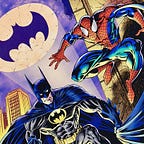The Selected Batman Re-Read, Part Seven — Batman RIP
I’d originally meant for this to be a much more comprehensive look at Grant Morrison’s extended tenure with the Caped Crusader, but there’s a certain poetry to ending with Bruce Wayne’s death in this penultimate Batman re-read post, before everything resets with Scott Snyder and Greg Capullo’s run in the New 52.
It’s definitely worth starting this era off with The Black Casebook, a collection of Golden Age Batman stories by Dick Sprang, Bill Finger and a bunch of other classic creators. While generally not my cup of tea, it’s still admittedly a fun little romp that, really, is pretty essential to appreciating and understanding Morrison’s run.
And that’s the thing with Morrison. I mentioned when talking about Arkham Asylum that understanding their intentions really helps with their stories. I certainly wasn’t as sure where they were going with Batman or what they were doing when I first jumped into these, but coming back to them with the benefit of reading their interviews has enriched their run.
The first two arcs—Batman and Son and The Black Glove—are easily the best of the lot. Andy Kubert is one of the most iconic superhero artists of his generation for damn good reason—with career-defining, wonderfully expressive art both in this story and in Whatever Happened to the Caped Crusader? (more on that later). JH Williams III’s work is, as mentioned before, simply phenomenal.
The stories themselves, however, are solid, each in their own way. Batman and Son is action-packed and delivers on Morrison’s promise to return Batman to the “hairy-chested love god” that he was in the seventies, while The Black Glove is an engaging mystery that teases more to come, without detracting from the main story itself.
My favourite story from this section of their run, however, was The Clown at Midnight, a prose issue that focuses on this idea of the Joker reinventing himself every few years. It’s a fascinating concept, one that not only adds to the Joker’s mythos, but also reinforces Morrison’s approach to their Batman story: that everything is canon.
(It’s probably best to skip The Resurrection of Ra’s Al Ghul though. Adding nothing to Morrison’s grand design, it breaks the pace of their run with an uneven crossover across a number of Bat-books.)
Batman RIP has gotten better with that more well-rounded context. While not as good as those first two arcs, it’s definitely interesting, if for no other reason than how Morrison handles continuity, as well as concepts like The Batman of Zur-En-Arrh and Batmite.
The biggest surprise of this era for me, however, was Final Crisis. First off, I’m generally not a fan of modern-day comic events. And when I’d initially read it, I think I was expecting weirdness, for sure—it’s still a Grant Morrison comic, after all—but mostly just your usual loud superhero shenanigans.
While Final Crisis has those big ol’ fights, it’s more Morrison than I’d have thought DC would’ve gone with for an event. There are some seriously big ideas at play here, toying not just with DC’s Multiverse, but the very notion of that Multiverse as a work of fiction. It gets a bit crazy at times, and some of it doesn’t land as well as others, but that almost doesn’t matter. What does is the sheer scale and bonkersness that Morrison managed to get away with. And, if nothing else, I can’t help but respect that.
But we’re straying a bit from Batman now. The big moment from the penultimate chapter of Final Crisis is Bruce’s “death”—and, really, if he’s going to go out, it feels fitting that, after this entire re-read, Morrison’s hairy-chested love god goes out while taking on another god. But Bruce’s “death” is just that: a big moment, sure, but a moment nonetheless in a much bigger story, so you’re not really given time to absorb it, especially since no one really expected it to be a real, honest-to-goodness, proper and permanent death.
Which isn’t to say that there isn’t time after for an emotional send-off to the dearly, not-quite-departed Dark Knight.
That’s where Neil Gaiman and Andy Kubert’s Whatever Happened to the Caped Crusader? comes in.
As Gaiman puts it in his intro, the story’s meant to be a farewell to Batman, no matter when he dies. Despite that timeless aspect to it, it’s still certainly a great cap to this portion of Morrison’s run because—whether intentional on Gaiman’s part or not—it complements Morrison’s approach to continuity by bringing together different eras and interpretations of the character, all to drive one point home: Batman never gives up.
Circling back to Morrison just before we bring this post to a close, we’ve got Time and the Batman, which works more as a supplementary than a complementary volume. The main story’s a nice post-script to all that’s come before, while delivering on the promise from the opening pages of the previous arc — that Batman and Robin will never die. RIP: The Missing Chapter strengthens the bridge between Final Crisis, Batman RIP and the rest of Morrison’s run, but isn’t exactly essential to connect any of those. (There’s also a one-off story by Fabian Nicieza and Cliff Richards that, while enjoyable, is clearly there to just fill up the page count.)
A lot of things have been said about Grant Morrison’s run over the years, but I think the word that suits it best and doesn’t get used often enough is probably “loving.” Their tenure doesn’t just reinforce the malleability of Batman — the grim hero, the adventuring genius and, yes, the hairy-chested love god — but also why the character has endured for so long.
